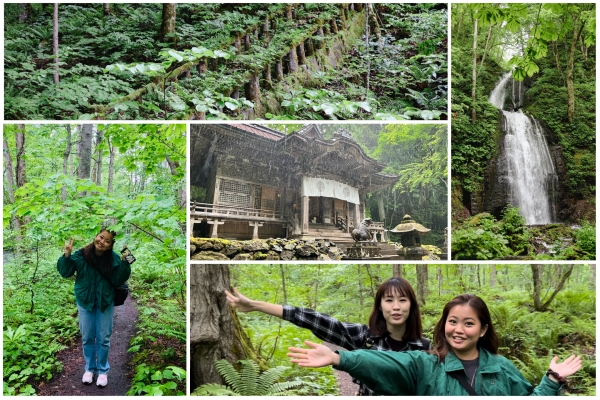Shinryoku season: A beginner’s trip to Oirase Keiryu and Lake Towada

When it comes to nature in Japan, the Tohoku Region (東北地方 Tohoku-chihō) is home to some of the best sceneries ranging from mountains and highlands to rivers and lakes. It is said that one of the most underrated seasons to explore nature’s best is during the shinryoku season (新緑) between mid-May to early July! What’s shinryoku, you may wonder? Shinryoku literally translates as “new green”, which means that in many nature spots you are treated to a wonderful hue of light and bright green at every turn!
Excited to be in Eastern Japan! (Image credit: JR East / Sue Lynn)
At the start of the month, my colleagues and I got the opportunity to visit some of Eastern Japan’s most amazing shinryoku spots right in the middle of this wonderful shoulder season. So when posed the question “Sue, where would you like to go to experience shinryoku?”, my brain immediately thought of Oirase Keiryu (奥入瀬渓流).
Since my colleague Carissa has written quite extensively about Oirase Keiryu, my sharings will mainly be from my own experience as someone with little to no hiking bone in me, including a boat ride in the formidable Lake Towada (十和田湖 Towadako) and a visit to the mysterious Towada Shrine (十和田神社 Towada-jinja). So strap on your hiking shoes, and follow along!
Getting to Oirase Keiryu

Map of the 14-km long Oirase Keiryu trail from Yakeyama to Nenokuchi. (Image credit: JNTO)
Oirase Keiryu is a picturesque stream that flows along the Oirase Gorge from Lake Towada, the largest caldera lake in Japan’s Honshu Island. Both spots form the northern part of the Towada-Hachimantai National Park (十和田八幡平国立公園 Towada-Hachimantai Kokuritsu Kōen). If you’re a nature lover, you will be thrilled to know that you can walk alongside this scenic stream and be one with the valley’s lush greenery that stretches 14km long, from Yakeyama (焼山) to Nenokuchi (子ノ口) which is the mouth of the stream.
JR Bus Tohoku at Hachinohe Station West Exit (八戸駅西口). (Image credit: JR East / Sue Lynn)
By public transport, you can get to Oirase Keiryu from either Aomori Station (青森駅 Aomori-eki) or Hachinohe Station (八戸駅 Hachinohe-eki). Together with my colleagues, I took the JR Bus Tohoku from the latter station at its West Exit, which departed at two timings on the day of our visit: 9:35am or 1:20pm. If you’re a JR EAST PASS or Nationwide JR Pass holder, you’d be pleased to know that this bus ride is covered by the pass—yay to free bus rides!
Oh, so green! (Video credit: JR East / Sue Lynn)
The bus drives pass Towada Art Center (十和田市現代美術館 Towadashi Gendai Bijutsukan), and makes a 10-minute pit stop at Oirase Roman Park Roadside Station (道の駅奥入瀬ろまんパーク Michi-no-Eki Oirase Roman Pāku) before heading to Oirase Keiryu Onsen (奥入瀬渓流温泉) and Yakeyama—the trail’s starting point. Depending on where you stop along the trail, the bus ride takes around 1 hour 30 minutes to 2 hours. Even on the bus ride, I was already in awe of all the greenery around me!
Oirase Keiryu & Oirase Gorge

(Image credit: JR East / Sue Lynn)
Experienced hikers with time to spare usually start their 4–5-hour hike from Yakeyama to Nenokuchi. But for beginners (like me) or those who just want to have a taste of what Oirase Keiryu has to offer (also me), consider alighting at Kumoi-no-taki Falls Bus Stop, which serves as a good midpoint between both points of the trail. That’s precisely what we did after arriving at about 11:25am, and what awaited us was a good 2-hour hike along the remaining 8km of the flat trail.

(Image credit: JR East / Sue Lynn & Julia Yee)
But first, let’s take a moment to admire the stunning Kumoi-no-taki Falls (雲井の滝)! Though not large in size, the abundant waterfall being surrounded by the forest’s thick greenery was a sight to behold and it is said to be one of the trail’s most beautiful waterfalls. After spending a few minutes snapping some photos, it was time to start hiking!

There are benches along the way for hikers to take a rest and admire nature’s beauty. (Image credit: JR East / Sue Lynn)
But with shinryoku, comes tsuyu (梅雨)—Japan’s rainy season. Although it wasn’t quite tsuyu season yet in Northern Tohoku, it did rain the whole week of our visit—the ground was still wet from yesterday’s rain and it started drizzling. I looked at my new, white sneakers (amateur mistake, I know) and started to panic a little. But I tried not to let the rain dampen my mood! Fortunately, the trail was still pretty walkable thanks to well-made pavements with generally little to no incline. Also, Oirase Keiryu is said to “come alive” when it’s rainy, as you can see mist fogging up at certain parts of the valley especially in the early morning, elevating the hike to a more mystical plane.

A moss-covered tree dipping into the Oirase Stream, Shironunono Falls, and lots of fern along the stream. (Image credit: JR East / Sue Lynn)
I was also told that bears do lurk around the area especially after winter, but (un)fortunately we were not met by any. Instead, we saw a couple more waterfalls and many varieties of flora—from moss, ferns, to trees—and fauna along the way. The gentle gushes of the stream coupled with nature’s fresh air and serene greenery, the hike helped relax all of my five senses.

Oirase Gorge's captivating moss-covered stairs. (Image credit: JR East / Sue Lynn)
While the entire trail was scenic and picturesque, the one image that remains in my mind till today is the moss-covered stairs pictured above. It was beyond breathtaking, straight out of a Ghibli movie (Princess Mononoke, anyone?) which looks way better in person. You’ll see this bridge roughly around 20 minutes from the start of your hike. What’s even better is the view that awaits you on top of the stairs! Needless to say, we spent quite a bit of time here just admiring the beauty of it all.

Waddling with our brollies. (Image credit: JR East / Sue Lynn)
Realising that we were running out of time—we had to reach Nenokuchi by 1:20pm—we picked up our walking pace. Unfortunately, so did the rain—the light drizzle at the start of our hike became heavier on the second half of our trail, and the path became loamier and muddier. We braved through the rain and eventually brisk-walked on the asphalt road which was a much dryer (and better) alternative for our wet shoes. This also caused us to miss out on an up-close view of the other beautiful waterfall—Choshi Otaki Falls (銚子大滝), Oirase Gorge’s largest waterfall, which we had to sadly admire from afar.
Lake Towada

Boarding the Lake Towada Pleasure Boat, with gloomy skies behind. (Image credit: JR East / Sue Lynn)
After 2 hours, we finally made it out of the trail at Nenokuchi where our next adventure awaits us—Lake Towada! At Nenokuchi, we hopped onto (ran to, more like) the Lake Towada Pleasure Boat (十和田湖遊覧船 Towadako yūransen) at the lake’s pier. A one-way ticket costs ¥1,500 for adults and brings you on a 45-minute cruise towards the lake’s south at Yasumiya (休屋).

(Image credit: JR East / Sue Lynn)
At first, we were surprised that we were one of the only groups of people onboard the boat. But considering how foggy and wet the weather was, we quickly figured out why. Nonetheless, it was an enjoyable and relaxing experience having the boat almost all to ourselves while the boat cruised past the lake’s islets. It was also a much needed break from the non-stop walking we did earlier on! Onboard, you can also help yourself to warm coffee (¥300) and snacks. And if you’re thinking of treating yourself further, you can top-up ¥500 for a green seat pictured bottom right.
Lake Towada Pleasure Boat (十和田湖遊覧船)
Address: 473 Towadakohannenokuchi Okuse, Towada, Aomori 034-0301
Nearest bus station: Nenokuchi Bus Station (JRバス子ノ口駅)
Access: 1-minute from Nenokuchi Bus Station
Admission fee (One-way): ¥1,500 (Adult), ¥750 (Child)
Tel: +81 176-75-2909
Yasumiya

It's called "Rainy pier fashion", sweetie, look it up. (Image credit: JR East / Sue Lynn)
We arrived at Yasumiya, where you get to (as the name suggests) rest and relax. Apart from guest houses and hotels, Yasumiya is also where you can purchase local souvenirs and try out local delicacies in the many shophouses, restaurants, and quaint cafes.

(Image credit: JR East / Sue Lynn)
One of the buildings that you’ll notice easily is JR Bus Towadako Station (JRバス十和田湖駅) where the JR Bus Tohoku will pick you up from. There is also a souvenir shop on the 1st floor and a dining facility JR House Towada on the 2nd. Unfortunately, the diner was closed so we had lunch at the nearby Towada Shokudo (十和田食堂), which was thankfully one of the only few shops open during that rainy day.
JR Bus Towadako (JRバス十和田湖駅)
Address: 486 Towadakohanyasumiya, Okuse, Towada, Aomori 018-5501
Tel: +81 176-75-2153
Towada Shokudo (十和田食堂)
Address: 486 Towadakohanyasumiya, Okuse, Towada, Aomori 018-5501
Nearest bus stop: JR Bus Towadako (JRバス十和田湖駅)
Access: 4-minute walk from the bus station
Opening hours: 9:30am–3pm (Daily)
Tel: +81 176-75-2768
Towada Shrine
(Image credit: JR East / Sue Lynn)
With some time to spare before our bus arrived, we took a stroll towards Towada Shrine, a Shinto shrine built in the 9th century that is dedicated to the gods of the lake. I’ve been to a couple of shrines in Japan, and I don’t mean to sound dramatic, but this was by far one of the most serene and peaceful shrines I’ve ever visited. The main shrine’s architecture is dated but majestic. Perhaps it was also because the shrine was nestled in a forest of tall cedar trees, but I felt a surge of spiritual energy around me as we made our way to the shrine.

Entering Towada Shrine through the Avenue of Cedars. (Image credit: JR East / Sue Lynn)
Towada Shrine was also said to be built to appease the water gods for safe navigation through the waters of Lake Towada. Since then, it’s considered a tradition for those who cross the lake to walk through the “Path of Luck” and pay their respects at the shrine, and throw coins on the shore for good fortune.
Statue of Maidens located at the shore of Lake Towada. (Image credit: JR East / Sue Lynn)
The “Path of Luck” also happens to be part of a short hiking trail dotted with several torii gates, each one with a different meaning. At the end of the path, we were met by the Statue of Maidens (乙女の像 Otome-no-zō), a symbol of Lake Towada. This bronze statue was built in 1953 to commemorate the 15th anniversary of the designation of Towada-Hachimantai National Park and is also known as the last work of sculptor and poet Takamura Kotaro (高村光太郎). On a clear day, the statue stands tall amongst the majestic landscape of Lake Towada.
Towada Shrine (十和田神社)
Address: 486 Towadakohanyasumiya, Okuse, Towada, Aomori 018-5501
Nearest bus stop: JR Bus Towadako (JRバス十和田湖駅)
Access: 10-minute walk from the bus station
Tel: +81 176-75-2508
It's time to go home... (Image credit: JR East / Sue Lynn)
We strolled along the lakeshore en-route back to JR Bus Towadako Station. We also bought some souvenirs to remember the trip by, including Apple Sake (Aomori is famous for apples!) before boarding the bus back to Hachinohe Station. While the trip did involve a lot of walking (I took a good 30-minute nap on the bus), I left the Oirase-Towada area wanting more—life is about taking time to appreciate nature's beauty even if it means taking a 2-hour hike! If I had a day to spare in my next visit to Northern Tohoku between spring and autumn, I would most definitely return to explore more of this area with better weather—and so should you!
If you want to find out more about our trip to the various shinryoku spots in Eastern Japan, join my colleagues and I for a virtual tour at Japan’s Green and Great Shinryoku Show @#StayAtホーム. You can watch the recorded event in the video above, or on Facebook as well as YouTube. See you at the Shinryoku Show!
Header image credit: JR East / Sue Lynn





